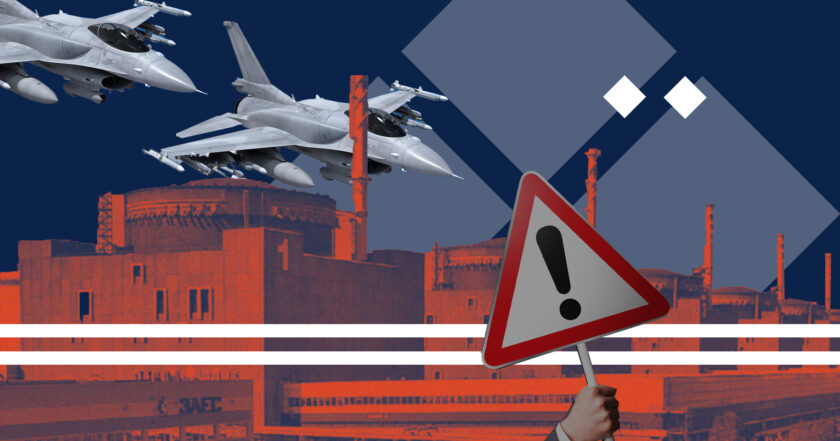Tensions at Zaporizhzhia NPP and Ukraine’s counteroffensive progress: key trends in Ukraine’s wartime reality

International Developments
- The training schedule of Ukrainian pilots and technical personnel on F-16 fighter jets is shifting.
The training was supposed to start last month, but this did not happen, according to Ukrainian Foreign Minister Dmytro Kuleba.
The first batch of F-16s was expected to arrive at the beginning of Autumn, but the timing of the transfer of these combat aircraft to Ukraine might also shift.
- Preparations for the Vilnius NATO Summit are underway.
Ukraine's Western allies are finalizing the preparations for the next July 11-12 NATO Summit in Vilnius, Lithuania.
Among the key issues of the Summit are
- Ukrainian future NATO ascension and security guarantees;
- reviving NATO's strategic military plans to counter Russian threat;
- further strengthening NATO's Eastern flank in terms of the growing hybrid threat from Belarus (likely to be hosting Russian tactical nukes and remnants of the Wagner PMC) and Russia itself.
War/Security Situation
- The Ukrainian counteroffensive is progressing steadily.
Ukrainian counteroffensive against Russian forces has been "particularly fruitful" in the past few days, and Ukraine's troops are fulfilling their primary tasks.
Russia still holds swathes of territory in eastern and southern Ukraine, but Ukrainian President Volodymyr Zelensky said on Monday that Ukrainian troops had progressed after a "difficult" week.
Ukrainian forces are making slow but steady progress pushing Russian troops deeper into their defense lines and looking for potential weak spots in their defenses to push through with the strategic reserves when the time is right.
- Russian forces are threatening to blow the Zaporizhzhia NPP.
Ukrainian officials and intelligence officials warn Russia could be preparing to blow up Zaporizhzhia Nuclear Power Plant, leading to a radioactive environmental disaster.
After the Kakhovka dam destruction last month, Kyiv fears the Kremlin plans to organize an explosion at the Zaporizhzhia Nuclear Power Plant, the largest in Europe, in the Russian-occupied city of Enerhodar.
As Russian leadership realized they were mostly denied using nuclear weapons in the aggressive war they were fruitlessly waging against Ukraine, they turned to another instrument capable of dealing roughly the same damage as weapons of mass destruction – destroying industrial and/or energy facilities in Ukraine.
Kremlin utilizes this instrument to slow or eventually stop the Ukrainian counteroffensive and to thwart Western military support to Ukraine.
Although the IAEA found no evidence of the immediate preparations for the blow-up, the Agency's mission did confirm that certain parts of the Zaporizhzhia NPP were laden with mines and explosives.
- Wagner in Belarus to become Russia's hybrid shock troops against the West.
Following the failed Wagner mutiny, Russia's Putin tries to resemble his leadership and to push his opponent Prigozhyn and his militia as far from Russian information, geographical and political landscape as possible.
Though PMC Wagner Group was virtually dissolved and vastly incorporated into the Russian regular military, Prigozhyn himself and his loyal mercenaries were allowed to leave for Belarus with all their money and weaponry, directly under the protection and personal responsibility of the self-proclaimed "president" Lukashenko.
The move might indicate that Russia is preparing another addition to its hybrid arsenal to slowly shift the focus of its aggressive policy from Ukraine to NATO and generally the "collective West".
Conclusions and Recommendations
- Training schedule of Ukrainian pilots and technical personnel on F-16 fighter jets is shifting.
The first batch of aircraft was expected to arrive in early Autumn; roughly at the same time, Ukraine was looking forward to receiving US M1A1 Abrams main battle tanks and additional Bradley IFVs.
This makes perfect sense as senior Ukrainian military leadership stresses the need for modern combat aircraft to proceed with the counteroffensive operations, which is impossible without air superiority.
The shift seems to be more of a political issue, as there were numerous statements from the participants of the International Aircraft Coalition urging for unified steps and avoiding the contradictions of the former International Tank Coalition.
The Western allies could speed up the training preparations of Ukrainian military pilots, as this is a final part of the training process started earlier this year in Great Britain, France and the United States.
- Preparations for the Vilnius NATO Summit are underway.
Despite official Kyiv's expectations to receive an official invitation to join NATO in Vilnius, it is more likely that Ukraine will get instead a political framework decision on its future non-MAP ascension to the Alliance after the war's end.
Ukraine should continue focusing on more practical matters, such as individual diplomatic efforts and work with every NATO member state to ensure maximum support of the future Ukrainian rapid ascension to the Alliance. As of this week, 22 of 31 NATO member states officially supported the idea.
Another critical issue for official Kyiv is to coordinate its efforts with the Alliance to reach all the NATO standards (aside from the military-related ones) as soon as possible to ensure the non-MAP ascension goes as expected when the time comes.
- Ukrainian counteroffensive is progressing steadily.
Despite some high expectations from certain of Ukraine's Western allies, the progress of the UAF counteroffensive directly reflects two significant factors: (1) Russian troops have built up tens of kilometres' deep defense lines along the 1200 km frontline; and (2) UAF lacks a few key instruments to speed up operations against the enemy exceeding it in numbers – long-range strike capabilities and air superiority.
The first is impossible without ATACMS and other long-range strike systems enabling Ukrainian forces to decimate Russian logistics and command/communication infrastructure.
The second calls for F-16s which would allow Ukrainian AF to deny Russians any ability to use guided bombs and its attack aircraft fleet to threaten Ukrainian advancing land forces.
These arguments need to be heavily debated with Ukraine's Western allies, who need to intensify military aid sent to Ukraine to meet the counteroffensive demands promptly to ensure its maximum success.
Among the top priorities are artillery ammo, long-range strike systems, and modern military aircraft to ensure Ukrainian air superiority – a key factor in all Western military operational doctrines.
- Russian forces are threatening to blow the Zaporizhzhia NPP.
At the moment, Kremlin uses the threat to blow Zaporizhzhia NPP as a hybrid blackmail tool to warn off Western nations from reaching practical decisions on Ukraine's ascension to NATO during the 11–12 July Summit in Vilnius.
However, the West is starting to react to the threat. First, with an urgent visit of IAEA head Mr Grossi to Ukraine and Russia. Second, two US Senators, Lindsey Graham (Rep) and Richard Blumenthal (Dem) proposed a resolution to consider any potential nuclear or radioactive attack by Russia as an attack against NATO, given that radioactive waste spreads to NATO countries.
This is the first time the Kremlin's alleged use of nuclear weapons is tantamount to blowing up nuclear power plants.
Ukraine has to press both Western allies and China to halt Russian plans to proceed with its terrorist tactics after blowing up the Kakhovka dam.
- Wagner in Belarus to become Russia's hybrid shock troops against the West.
Prigozhyn and Wagner's relocation to Belarus indicates that Russian president Putin wants to keep his hands on Wagner's hybrid tool, this time using Belarus' "president" Lukashenko as a proxy.
This might give Kremlin much more flexibility in utilizing the newly-recreated hybrid shock troopers against NATO member states, namely Poland and Lithuania.
Russian Wagner Group shock-troops relocation to Belarus turns the latter into Kremlin's hybrid aggression hub against NATO by:
- launching border/cross-border provocations into Poland and/or Lithuania;
- scaling up nuclear blackmail by blending Wagner in the scheme.
- Ukraine, Poland, Lithuania and other NATO allies need to join efforts and resources to sustain and counter this new potential threat, denying Kremlin any additional advantage against the civilized world.
US and NATO allies urgently need additional tools to monitor, deter and, if necessary, address these new hybrid threats posed by Prigozhyn's mercenaries in Belarus.
Ukraine could play a key role here, using its vast experience in dealing with the Wagner militia on the battlefield as a strike force and accompanied by other hybrid instruments from the Kremlin playbook.
This policy brief was prepared exclusively for "Rubryka" by Ilko Kucheriv Democratic Initiatives Foundation as part of a project "russia-Ukraine Conflict: from Full-Scale War to Conflict Resolution and Post-War Reconstruction" implemented in cooperation with the Razumkov Centre with the support of the MATRA program of the Embassy of the Netherlands. The opinions expressed are those of the author(s) only and should not be considered as representative of the Embassy's official position.






















































